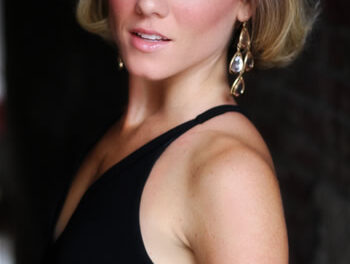The Raleigh Chamber Music Guild‘s “big” series of concerts, the “Masters Series,” generally presented in Fletcher Opera Theater, brings big-name national and international artists to the capital for distinctive programs. For its final downtown offering of the season, the Guild featured a brilliant trio headed by pianist Navah Perlman and graced by comparably splendid young string players Philippe Quint, violin, and Zuill Bailey, cello. Perlman and Bailey have long-standing ties to Raleigh and central NC, she having been one of the first “outside” soloists of note to have graced a concert by the Raleigh Symphony Orchestra, and Bailey having long been a favorite here among chamber and orchestral music circles. The trio seemed a logical pick for the RCMG’s season finale, and it made sense to have them be the chief attraction for the presenter’s annual fund-raising gala, too. Enter the sequester! Quint and Bailey arrived in Raleigh with time to spare, but Perlman’s flight was delayed and delayed and delayed again, ostensibly (she said) due to mechanical problems, but why not blame congress, that collection of albatrosses that burden the nation’s collective neck? As a result, the string players improvised a Saturday night program (at Richard Ruggero’s piano emporium!) consisting of three Bach cello suite preludes, delivered with breathtaking brilliance and insight, two relatively short excerpts from John Corigliano’s score for The Red Violin, and the most dazzling performance of the Handel-Halvorsen violin-cello Passacaglia anyone present is likely ever to have heard. Indeed, it reminded one listener of Franco Corelli trying to out-sing Birgit Nilsson, back when both were in their prime. And more than a few sensed that the excitement and passion these young artists brought to the hairpin twists and turns in the Passacaglia perfectly encapsulated the hope all lovers of chamber music have for the future, a future being made secure by this new generation of dynamic “super players.”
The visit also included a Sunday morning master class in Smedes Parlor, at Saint Mary’s School, during which violinists Rebecca Shen and Samuel Zhu, violist Vishnu Gottiparthy, and cellist Grace Kim worked with the visiting artists on part of Shostakovich’s Quartet No. 7 that had served as a prelude to the previous evening’s gala festivities and that was heard yet again during a pre-concert program in the Fletcher lobby. Other class (and pre-concert) participants hailed from the Duke University String School, MYCO@UNC (two ensembles), and ECU. These groups, coached by some of our best regional artist-teachers, played some very good music (by Rachmaninoff, Turina, Beethoven, and Suk) and reinforced the hope of music lovers in attendance for the future; with young players like these in the pipeline, the prospects are bright.
It was during this master class that Bailey announced the morning’s sad news of the death of cellist Janos Starker, to whom the afternoon program would be dedicated (and during which Bailey gave several informative and touching reminiscences from his collection of Starker stories.)
The Sunday afternoon program went through several metamorphoses since first announced last year, along the way, losing Beethoven’s “Kakadu” Variations and the “Archduke” Trio plus Brahms’ Trio in C Minor, and in their place gaining Beethoven’s “Gassenhauer” Trio (originally for piano, clarinet, and cello) and the second trios of Shostakovich and Brahms.
To describe this concert as “exceptional” would be to understate the case. A great deal has been written about the music, of course, and while Beethoven’s Op. 11 is not often heard, all three works are well known in chamber music circles. What elevated this performance considerably above the norm was the playing of the visiting artists. Each is a splendid soloist, and the ensemble has been together for a long time – Quint is a fairly recent arrival, but he has fit into the framework superbly. These people are brilliant intellectuals and gifted artists who have keen insight into the music they play. They possess technique in superabundance, so even difficult passages seem easy – and often elicit knowing and appreciative smiles and other acknowledgments from each other. Of course, all the other hallmarks of great playing are present in abundance: incisiveness, energy, skillful blends of tension and relaxation, precise attacks and releases, scrupulously-managed dynamics – you name them, and all the best musical qualities informed these artists’ collective work.
Thus the Beethoven was a transport of joy and delight, with infectious interplay among all three musicians. The Shostakovich was set up with those aforementioned remarks about Starker and a Navah Perlman story of the composer telling a visiting quartet how to interpret his music by taking them on a walking tour of his neighborhood and its cemetery. Many members of the audience surely had heard this score, but just as surely few if any are likely to have heard it delivered with such stark intensity, sometimes bordering on despair, and with such haunting passion. It its wake, the Brahms came as a relief, reminding us that life can and does go on; this glowed from within, its occasionally autumnal lines seeming to reflect sunshine like leaves in light breezes, just starting to turn. The scherzo infectiously conveyed the greatest excitement, and the finale was a demonstration of barely bridled joy, flawlessly realized. The uproar at the conclusion of the concert was considerable, with many members of the audience standing and cheering their approval. Yes, it was that good. Again it is clear that the future of this art is secure, so long as artists like Perlman, Quint and Bailey continue to ply their trade at these exalted levels.
PS The piano was a Bösendorfer 280, provided by Ruggero Piano.











